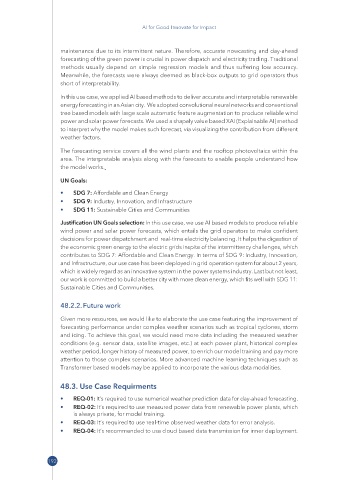Page 208 - AI for Good-Innovate for Impact Final Report 2024
P. 208
AI for Good-Innovate for Impact
maintenance due to its intermittent nature. Therefore, accurate nowcasting and day-ahead
forecasting of the green power is crucial in power dispatch and electricity trading. Traditional
methods usually depend on simple regression models and thus suffering low accuracy.
Meanwhile, the forecasts were always deemed as black-box outputs to grid operators thus
short of interpretability.
In this use case, we applied AI based methods to deliver accurate and interpretable renewable
energy forecasting in an Asian city. We adopted convolutional neural networks and conventional
tree based models with large scale automatic feature augmentation to produce reliable wind
power and solar power forecasts. We used a shapely value based XAI (Explainable AI) method
to interpret why the model makes such forecast, via visualizing the contribution from different
weather factors.
The forecasting service covers all the wind plants and the rooftop photovoltaics within the
area. The interpretable analysis along with the forecasts to enable people understand how
the model works.
UN Goals:
• SDG 7: Affordable and Clean Energy
• SDG 9: Industry, Innovation, and Infrastructure
• SDG 11: Sustainable Cities and Communities
Justification UN Goals selection: In this use case, we use AI based models to produce reliable
wind power and solar power forecasts, which entails the grid operators to make confident
decisions for power dispatchment and real-time electricity balancing. It helps the digestion of
the economic green energy to the electric grids inspite of the intermittency challenges, which
contributes to SDG 7: Affordable and Clean Energy. In terms of SDG 9: Industry, Innovation,
and Infrastructure, our use case has been deployed in grid operation system for about 2 years,
which is widely regard as an innovative system in the power systems industry. Last but not least,
our work is committed to build a better city with more clean energy, which fits well with SDG 11:
Sustainable Cities and Communities.
48�2�2� Future work
Given more resources, we would like to elaborate the use case featuring the improvement of
forecasting performance under complex weather scenarios such as tropical cyclones, storm
and icing. To achieve this goal, we would need more data including the measured weather
conditions (e.g. sensor data, satellite images, etc.) at each power plant, historical complex
weather period, longer history of measured power, to enrich our model training and pay more
attention to those complex scenarios. More advanced machine learning techniques such as
Transformer based models may be applied to incorporate the various data modalities.
48�3� Use Case Requirments
• REQ-01: It’s required to use numerical weather prediction data for day-ahead forecasting.
• REQ-02: It’s required to use measured power data from renewable power plants, which
is always private, for model training.
• REQ-03: It’s required to use real-time observed weather data for error analysis.
• REQ-04: It’s recommended to use cloud based data transmission for inner deployment.
192

